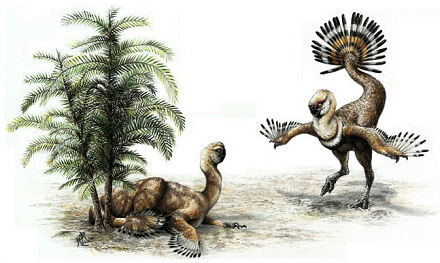6 January 2013
Fossil analysis indicates dinosaurs used feathers for courtship
by Will Parker

A University of Alberta scientist says that fossilized dinosaur tail bones provide strong evidence that feathered dinosaurs used tail plumage to attract mates, much like modern-day peacocks.
The fossil evidence, detailed in the journal Acta Palaeontologica Polonica, centers on a peculiar fusing together of vertebrae at the tip of the tail of four different species of dinosaurs, some separated in time and evolution by 45 million years.
Paleontologist Scott Persons says the final vertebrae in the tails of a group of dinosaurs called oviraptors were fused together forming a ridged, blade-like structure. "The structure is called a pygostyle," says Persons. "Among modern animals only birds have them."
Oviraptors were two-legged plant eating dinosaurs that roamed parts of China, Mongolia, and Alberta during the Cretaceous period, the final age of the dinosaur. No direct fossil evidence of feathers has been found with the fossils of the oviraptors, but Persons says there is still strong evidence they had a feathered tail.
He notes that the individual vertebrae at the base of an oviraptor's tail were short and numerous, indicating great flexibility. Based on dissections of modern reptile and bird tails, Persons reconstruction of the dinosaur's tail muscles revealed oviraptors had what it took to really shake their tail feathers. Large muscles extended far down the tail and had a sufficient number of broad connection points to the vertebrae to propel oviraptor's tail feathers vigorously from side to side and up and down.
"By this time a variety of dinosaurs used feathers for flight and insulation from the cold," said Persons. "This shows that by the Late Cretaceous dinosaurs were doing everything with feathers that modern birds do now."
In addition to feathered-tail waving, oviraptors also had prominent bone crests on their head, which Persons says the dinosaur may have also used in mating displays. "Between the crested head and feathered-tail shaking, oviraptors had a propensity for visual exhibitionism," he suggests.
Related:
Discuss this article in our forum
Birds are baby dinosaurs, say Harvard scientists
Prehistoric "terror bird" jabbed prey like a boxer
Extinction of dinosaurs a given thanks to fragility of their ecosystem
Oxygen Increase Behind Rise Of Mammals
Source: University of Alberta
